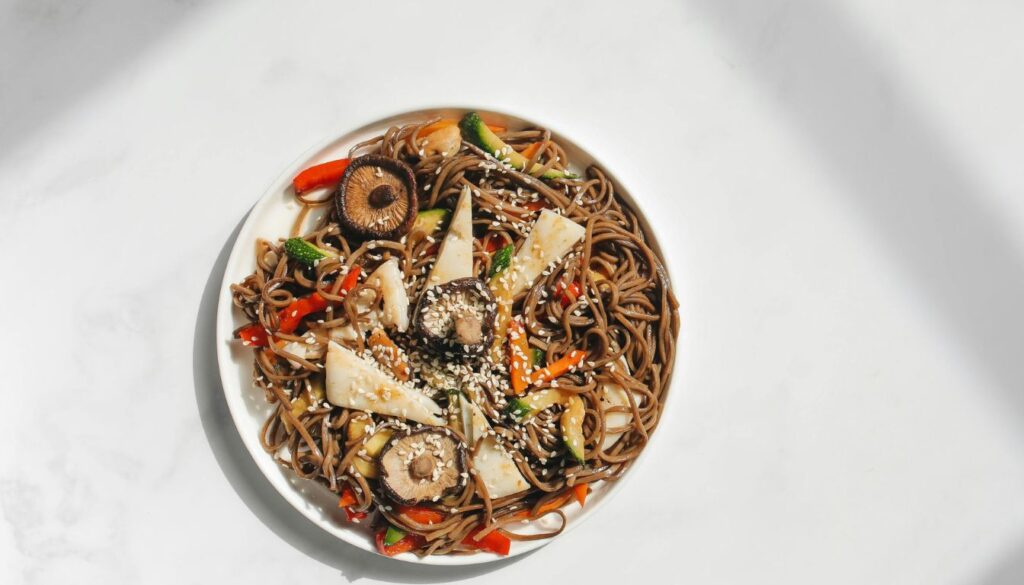When it comes to superfoods, shiitake mushrooms often fly under the radar, but they’re packed with incredible nutrients that can elevate your health. I’ve discovered that these delicious fungi not only enhance the flavor of my meals but also offer a wealth of benefits that make them a must-have in any diet.
Nutrients in Shiitake Mushrooms
Shiitake mushrooms are packed with nutrients, making them a valuable addition to my diet. They offer a range of macronutrients and micronutrients that support overall health.
Macronutrients – Shiitake Mushroom: Benefits and Nutrients for Healthy Diets
Shiitake mushrooms primarily contain carbohydrates, proteins, and fats. A 100-gram serving offers about 2.2 grams of protein. This protein contributes to muscle health and recovery. It also contains approximately 2–3 grams of carbohydrates, which provide energy. The fat content is lower, about 0.5 grams, making these mushrooms a lean option. What’s impressive is their low calorie count, around 34 calories per serving. Who knew something so tasty could also help keep my waistline in check?
Micronutrients
Shiitake mushrooms shine when it comes to vitamins and minerals. They provide essential nutrients like B vitamins, including niacin, riboflavin, and pantothenic acid. A 100-gram portion supplies around 1.5 mg of niacin, vital for energy metabolism.
Additionally, they contain copper and selenium. Copper supports the immune system and energy production, while selenium acts as an antioxidant. The presence of vitamin D is another surprising benefit, especially when exposed to sunlight. So, these fungi don’t just amp up my meals; they also boost my nutrient intake.
Ultimately, shiitake mushrooms bring a wealth of nutrients to the table. Incorporating them into my meals enhances both flavor and health benefits significantly.
Health Benefits of Shiitake Mushrooms

Shiitake mushrooms offer a range of health benefits that enhance well-being. I find them not just delicious but also a boon for my health.
Immune System Support – Shiitake Mushroom: Benefits and Nutrients for Healthy Diets
Shiitake mushrooms boost the immune system. These fungi contain polysaccharides, particularly beta-glucans, which help activate immune cells. Regular consumption of shiitake can lead to fewer colds and infections. Plus, antioxidants in them fight off harmful free radicals. Who doesn’t want a natural fighter in their corner?
Heart Health
Heart health benefits from shiitake mushrooms, too. They help lower cholesterol levels due to compounds like eritadenine. I appreciate that these mushrooms can support better circulation and reduce blood pressure. Adding shiitake to meals can be like giving my heart a little extra love.
Anti-Cancer Properties
Shiitake mushrooms show promise in cancer prevention. Research indicates they contain lentinans, which may help inhibit tumor growth. Studies suggest that these mushrooms can enhance the efficacy of conventional cancer treatments. Eating shiitake regularly feels like I’m adding a superhero to my plate, ready to battle!
Cooking and Preparing Shiitake Mushrooms
Shiitake mushrooms offer a delicious flavor while making meals exciting. Preparing them boosts taste and nutrition in various dishes.
Best Cooking Methods – Shiitake Mushroom: Benefits and Nutrients for Healthy Diets
I find several cooking methods work well for shiitake mushrooms. Sautéing brings out their rich, umami flavor. Heat olive oil in a pan, add sliced mushrooms, and cook for about five minutes. Roasting is another favorite.
Toss them in olive oil, sprinkle salt, and bake at 400°F for 15 minutes until crispy. Grilling shiitake mushrooms adds a smoky note. Just brush with oil and grill for 4-5 minutes per side. You can even enjoy them fresh in salads or soups. Each method enhances the mushroom’s unique taste and texture.
Nutrient Preservation in Shiitake Mushrooms
Shiitake mushrooms keep their nutrients well during cooking. Heat helps release beneficial compounds without destroying them. Cooking enhances flavors and maintains important vitamins.
I often find that steaming shiitake mushrooms preserves their nutrients best. Steaming for about five minutes retains more vitamins compared to boiling. The shorter the cooking time, the better the nutrient retention.
Drying shiitake mushrooms also maintains their nutritional profile. Dried mushrooms contain similar amounts of protein, vitamins, and minerals as fresh ones. When rehydrating, soaking in water brings back their nutrition and flavor.
It’s surprising how freeze-drying works, too. This method removes moisture while keeping nutrients intact. It allows easy storage without sacrificing health benefits. I love using freeze-dried shiitake mushrooms in soups and stews.
While it’s fun to experiment in the kitchen, know that overcooking can harm nutrients. Cooking shiitake mushrooms just enough ensures a delicious texture and flavor. Plus, lightly sautéing them with olive oil adds healthy fats, enhancing nutrient absorption.
Fresh shiitake mushrooms deliver vital nutrients quickly. Eating them raw or lightly cooked maximizes their health benefits. I enjoy tossing them in salads for a tasty crunch.
Overall, whether cooked, dried, or fresh, shiitake mushrooms are a powerhouse of nutrition. Their nutrient preservation methods make them an excellent addition to my meals. I appreciate the tasty benefits they bring, all while keeping my diet nutritious and healthy.
Before You Go – Shiitake Mushroom: Benefits and Nutrients for Healthy Diets

Shiitake mushrooms are more than just a delicious addition to meals. They’re a powerhouse of nutrients that can significantly enhance your health. From boosting your immune system to supporting heart health, these mushrooms offer a range of benefits that shouldn’t be overlooked.
Incorporating shiitake mushrooms into your diet is an easy way to elevate both flavor and nutrition. Whether you enjoy them sautéed, roasted or fresh in salads, their versatility makes them a fantastic choice for anyone looking to improve their dietary habits. With so many health advantages, it’s clear that shiitake mushrooms deserve a spot on your plate.
Don’t forget to add theherbprof.com homepage to your favourites so you don’t miss out on future articles.
References – Shiitake Mushroom: Benefits and Nutrients for Healthy Diets
Little Herb Encyclopedia, by Jack Ritchason; N.D., Woodland Publishing Incorporated, 1995
The Ultimate Healing System, Course Manual, Copyright 1985, Don Lepore
Planetary Herbology, Michael Tierra, C.A., N.D., Lotus Press, 1988
Handbook of Medicinal Herbs, by James A. Duke, Pub. CRP Second Edition 2007
The Complete Medicinal Herbal, by Penelope Ody, Published by Dorling Kindersley
Check the Following Article
Growing Dianthus Baby Doll: Low-Maintenance Perennial
DIY Tea Bags: Simple Steps for Customized Brews
Dry Orange Slices in the Microwave: Quick and Easy Guide
The Best Fruits to Grow Indoors: Tips for Thriving Gardens
Frequently Asked Questions – Shiitake Mushroom: Benefits and Nutrients for Healthy Diets
What are the main nutritional benefits of shiitake mushrooms?
Shiitake mushrooms are rich in macronutrients such as carbohydrates, proteins, and healthy fats while being low in calories—approximately 34 calories per 100 grams. They also provide essential micronutrients like B vitamins, copper, selenium, and vitamin D, contributing to overall health and immune support.
How do shiitake mushrooms boost the immune system?
Shiitake mushrooms contain polysaccharides, particularly beta-glucans, which activate immune cells and help bolster the immune system. Regular consumption may reduce the frequency of colds and infections, making them a valuable addition to a health-conscious diet.
Can shiitake mushrooms help lower cholesterol?
Yes, shiitake mushrooms may support heart health by lowering cholesterol levels and improving circulation. Compounds like eritadenine play a significant role in aiding these processes, potentially reducing the risk of cardiovascular diseases.
Do shiitake mushrooms have anti-cancer properties?
Research suggests that shiitake mushrooms contain lentinans, which may inhibit tumor growth and enhance the effectiveness of cancer treatments. Their antioxidant profile also helps combat harmful free radicals in the body.
What are the best cooking methods for shiitake mushrooms?
Sautéing, roasting, and grilling are excellent ways to enhance the flavor and nutrition of shiitake mushrooms. Sautéing in olive oil, roasting at 400°F for 15 minutes, or grilling for 4-5 minutes per side can bring out their rich umami taste.
How can I preserve the nutrients in shiitake mushrooms during cooking?
Steaming is a highly effective method for retaining the vitamins in shiitake mushrooms. Lightly sautéing them with olive oil can also enhance nutrient absorption. It’s best to avoid overcooking to preserve their nutritional benefits.
Are fresh shiitake mushrooms better than dried ones?
Fresh shiitake mushrooms provide a quick delivery of vital nutrients and can be enjoyed in salads or soups. While dried and freeze-dried versions retain many nutritional profiles, fresh mushrooms often have a richer flavor and texture, enhancing the overall culinary experience.

